In one of the biggest occasions in the history of the international market for Irish art, two major auctions of Irish interest will take place on the same day at Sotheby’s in London later this month. On September 27th the “Yeats Family Collection” will go under the hammer followed in the afternoon by the annual “Irish Art” sale of paintings and sculpture. The unprecedented double-Irish event, combined with the current strength of the euro versus sterling, is expected to attract strong interest from Ireland and the Irish diaspora.
Prospective bidders – and the general public – in Ireland will get a chance to view highlights from both auctions when they go on view in Dublin for three days this week, from Thursday, September 14th, at the Royal Hibernian Academy in Ely Place.
Yeats lots
TheYeats Family Collection features more than 200 lots which illustrate the literary and artistic life of Ireland’s best-known 20th-century cultural family. The collection comes from Cliff House, Coliemore Road, Dalkey, Co Dublin, which is the former home of poet WB Yeats’ son, the late Michael Yeats, a Fianna Fáil senator and MEP, who died in 2007, and his wife Gráinne, a harpist, who died in 2013. It is being sold by their children, Caitríona, Siobhán and Pádraig, who live abroad.
Almost half the lots will be on display at the Dublin viewing – the remainder can be viewed in the online catalogue at sothebys.com. The auction includes paintings, drawings and personal effects created or owned by the artist John Butler Yeats and his four children: the poet WB, embroidery designer Lily, printing press pioneer Lolly, and artist Jack. The combined top estimate is £1.9 million (€2.1 million).
The majority of the artworks have not been seen in public for more than 30 years, and the personal effects have never been exhibited before.
The Government granted export licences to allow the collection to be shipped to London for the sale after three Irish cultural institutions, the National Library, the National Gallery and the National Museum had been offered “first refusal”. Some items were acquired for the State but the bulk of the collection is to be auctioned.
The highlight is Lot 86, a collection of 130 letters between WB Yeats and his life-long friend and first lover, the English writer Olivia Shakespear, described as "of the highest importance to literary history" and estimated at £250,000-£350,000. But there are plenty of less expensive items. Among the more affordable and quirky lots are WB Yeats's rosewood, monogrammed hairbrushes (£800-£1,200); Jack B Yeats's artist's palette (£200-£300); the Yeats family dining table, acquired by WB Yeats with some of the money awarded to him for winning the Nobel Prize in 1923 (£1,500-£2,500); a textile by Lily Yeats illustrating her brother WB's poem The Lake Isle of Innisfree (£1,500-£2,500); Jack B Yeats's collapsible silk top hat (£500-£700); and WB Yeats's Chinese ivory chess set (£2,500-£3,500).
Annual event
Separately, Sotheby's annual Irish Art sale features 74 lots of paintings and sculptures, many appearing at auction for the first time. Artists featured include Sir John Lavery, John Luke, Jack B Yeats, Mary Swanzy and Colin Middleton.
The top lot is an early painting of the Swiss Alps by Sir John Lavery entitled The Summit of Jungfrau, described as “a powerful and masterly landscape painting” (£150,000-£250,000).
But there's also more affordable contemporary art including The Weekender, a new oil-on-canvas by Martin Gale depicting a caravan in a muddy Irish field (£7,000-£10,000) and Secret Lovers, a bronze by Dublin sculptor Rowan Gillespie (£15,000- £20,000).
10 highlights in the Dublin viewing of Sotheby’s auctions
The Summit of Jungfrau by Sir John Lavery
(£150,000-£250,000)
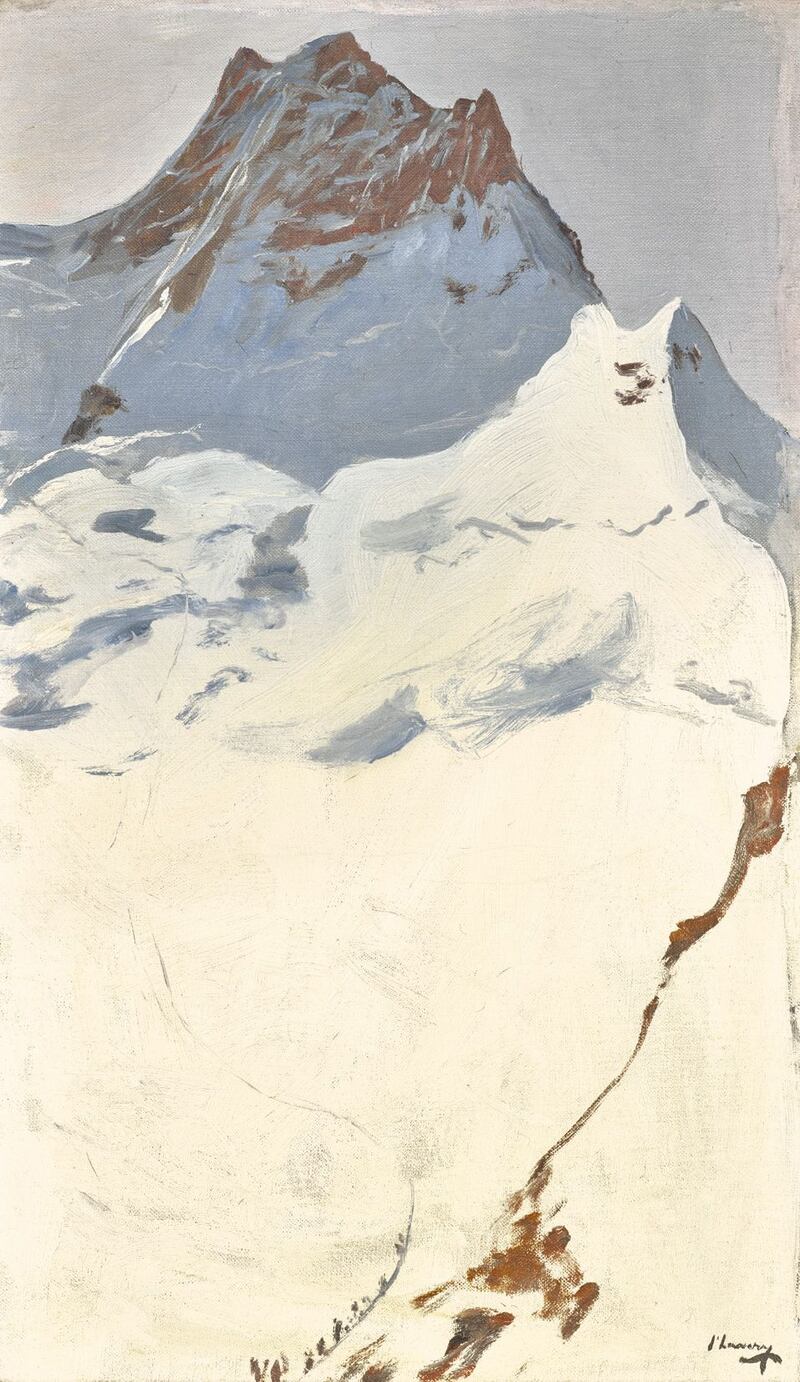
The oil-on-canvas painting, showing one of the highest peaks in the Swiss Alps is dated 1913, has been in a private collection in London and unseen in public for decades. It was painted by Lavery following a trip he made to the Swiss ski resort of Wengen, where he stayed at the Regina Hotel Blümlisalp with his wife Hazel, Lady Lavery, and stepdaughter Alice. Lavery ascended the mountain via the recently opened railway with his painting kit. Another painting by Lavery from this trip, the curiously titled Japanese Switzerland sold at Sotheby’s Irish Sale in 2015 for £509,000.
The Runaway Horse by Jack B Yeats
(£150,000-£250,000)

This oil-on-board painting dates from 1954. The title has caused confusion as the image does not, in fact, depict a horse but, instead, a child playing at being a runaway horse, holding his fists out in front as if trying to control the invisible animal.
The Fall by Basil Blackshaw
(£100,000-£150,000)

An oil-on-canvas, dated 1976, by the Northern Ireland artist who died last year. The painting captures the drama and risk of racing and shows a jockey coming close to walking on air. Blackshaw’s most famous painting is the privately owned Grand National (Foinavon’s Year) which depicts the moment in the 1967 Grand National when a chaotic pile up at one of the fences – since named Foinavon – forced almost all the horses and riders to fall and Irish horse, Foinavon, a 100-1 outsider won the race.
Northern Rhythm by John Luke
(£100,000-£150,000)
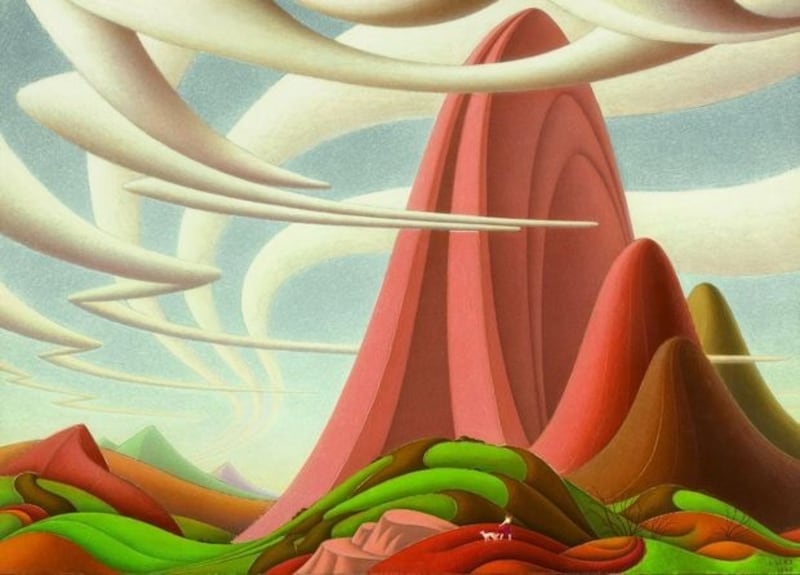
This tempera-on board painting, dated 1946, is by a little-known Northern Ireland artist who died in 1975. It was purchased from the artist by a private collector in 1965 and gifted to the present owner. Luke painted Northern Rhythm while living on a farm at Knappagh in Killylea, Co Armagh, where he had moved from Belfast, following the German air raids on the city in 1941. It is one of 12 small, jewel-like oil and tempera paintings he made there between 1943 and 1948. The painting depicts fantastical mountains, billowing clouds and, in the foreground, a female figure with a hound. Luke’s nephew recalled the artist telling him “while he painted Northern Rhythm he had Beethoven’s Sixth Symphony in his head”.
Sun on the Sails by Mary Swanzy
(£50,000- £70,000)

This oil-on-canvas is an abstract painting of billowing sails in the cubist style was purchased by the present owner in the 1970s from the Taylor Gallery in Dublin. Mary Swanzy, born in 1882, was the daughter of a wealthy Merrion Square eye surgeon, and is considered one of Ireland’s first “modern” artists. She travelled extensively and settled in London, where she died in 1978.
Railway Refreshment Room by Jack B Yeats
(£80,000-£120,000)
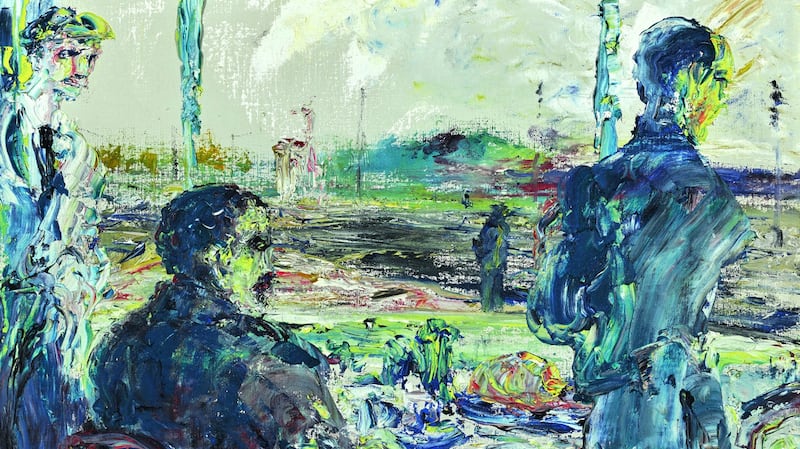
This oil-on-canvas dated 1946, which has been in a private collection and unseen in public for more than 50 years, depicts three figures in the dining car of a train as it travels through the Irish landscape. The travellers gaze out of the large windows as the countryside swirls past. The artist was a regular rail traveller and many of his paintings record his encounters with other passengers and the memories of the landscape rushing by.
Enignum II chair by Joseph Walsh
(£8,000-£12,000)

This is the first time the Irish Art sale at Sotheby’s has included a design piece. The chair, whose title derives from the Latin words “enigma” (mystery) and “lignum” (wood) is made of olive ash and upholstered in suede. Walsh is an Irish furniture designer whose studio is in Riverstick, Co Cork. His work is in the permanent collections of the National Museum of Ireland, the Pompidou in Paris, and the Devonshire collection at Chatsworth. A similar chair sold for £13,750 at Sotheby’s “Made in Britain” auction this year.
Self-Portrait, New York by John Butler Yeats
(£30,000-£50,000)
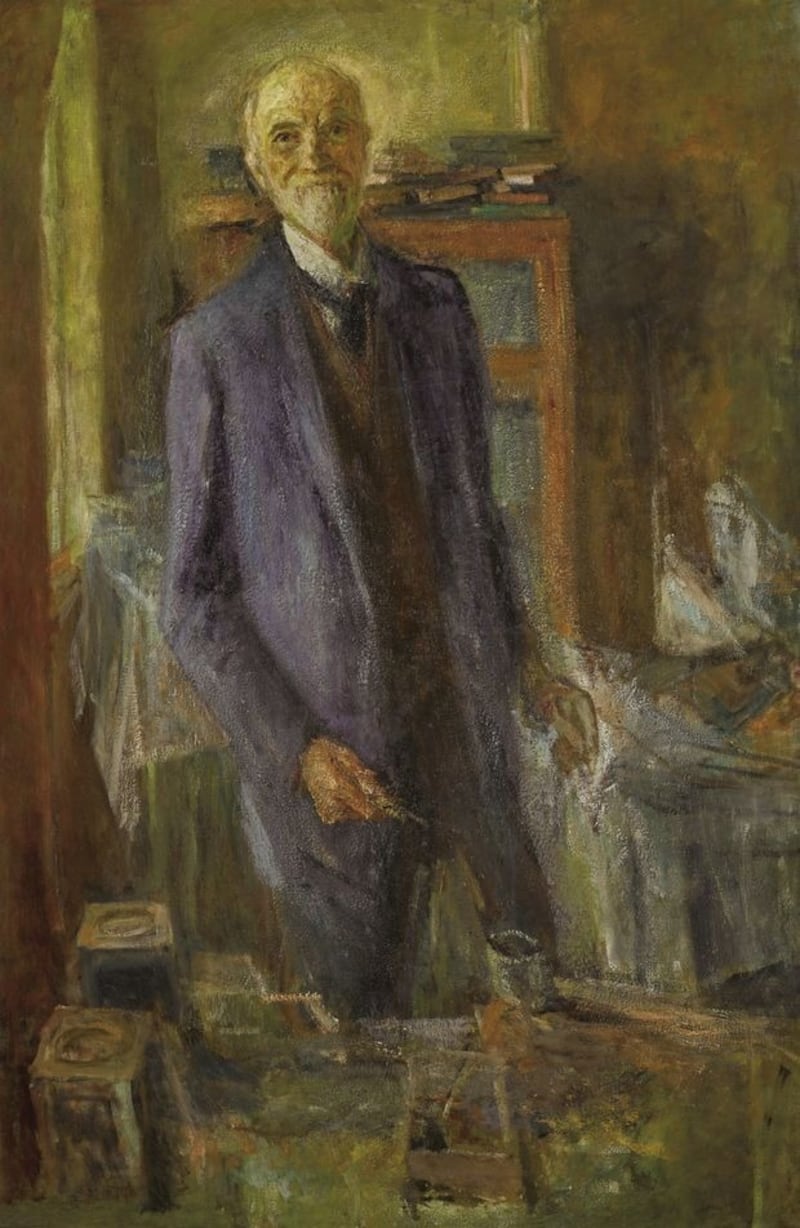
This oil-on-canvas was painted in New York where the artist moved in 1907 aged 68 and was completed sometime before 1922, when he died there. The painting was previously on loan to the National Gallery of Ireland. John Butler Yeats was best known for his portraits.
WB Yeats's writing desk
(£20,000- £30,000)
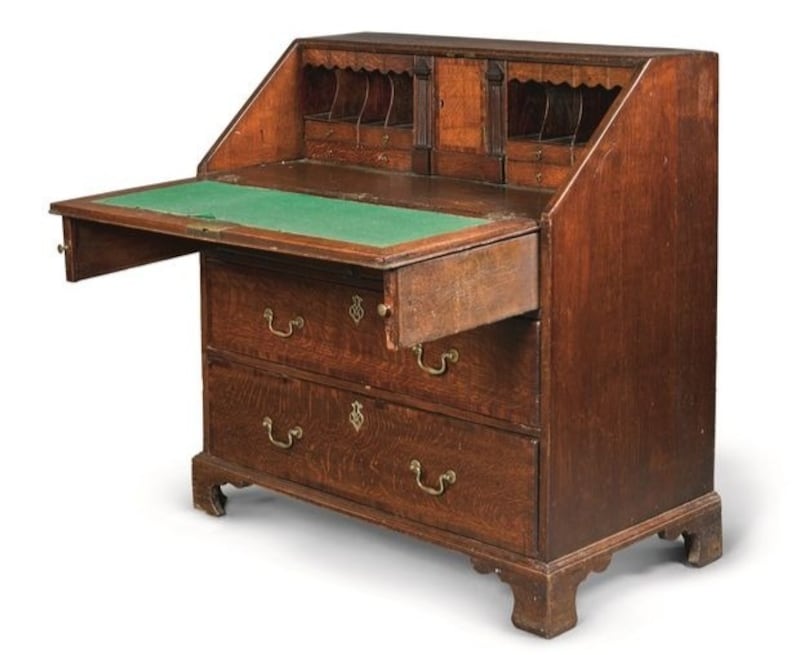
The 18th-century oak and mahogany desk was used regularly by Yeats in his later years. The desk has a green baize writing surface, eight pigeonholes, seven small drawers and four concealed compartments around a central cupboard. It was used by him at his houses in Galway, Merrion Square and Rathfarnham. Although it is being sold as a separate lot, the buyer of the desk might also want to bid on the poet’s desk-chair – a 19th-century elm and ash piece (£3,000-£5,000).
The Sunset Belongs to You by Jack B Yeats
(£100,000-£150,000)
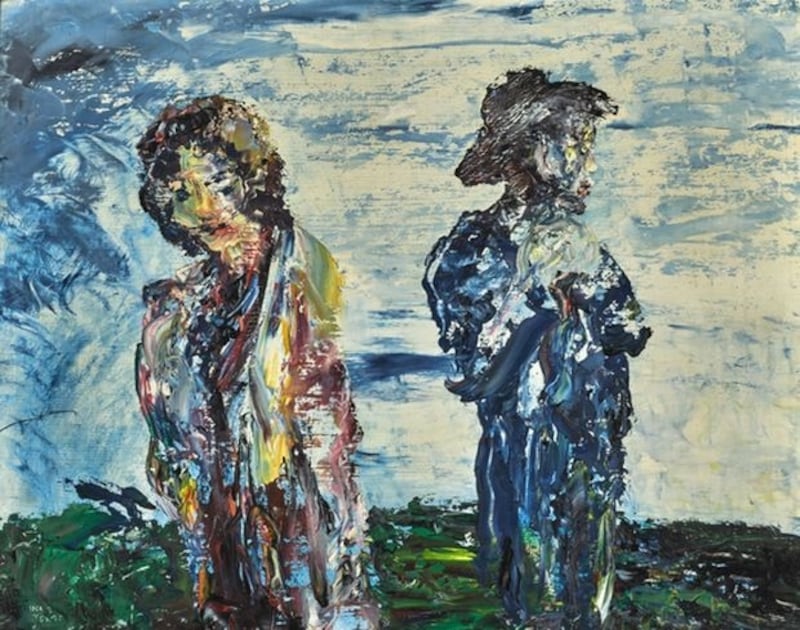
An undated oil-on-board painting which depicts a man in a wide-brimmed hat looking to the sky while a young woman beside him turns away. The man holds a handkerchief in his hand as if gesturing to the distance. In a catalogue note, Dr Róisín Kennedy, an expert on the artist, writes: “The drama of the encounter in The Sunset belongs to You is heightened by the theatrical poses of the figures whose bodies are silhouetted against an expanse of sky, with open ground of wild windswept foliage extending to the distant horizon behind them” and that “Yeats’s keen understanding of drama is evident in the way that this simple composition conveys emotional intensity, arousing the viewer’s curiosity and empathy with its two protagonists”.












